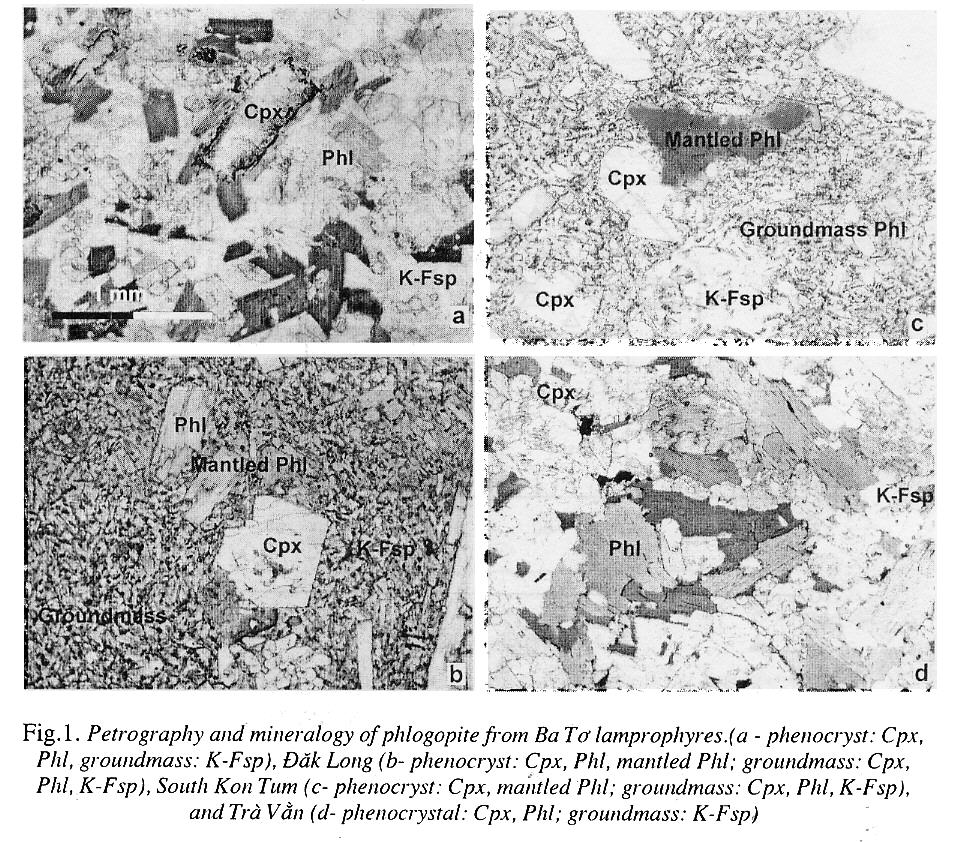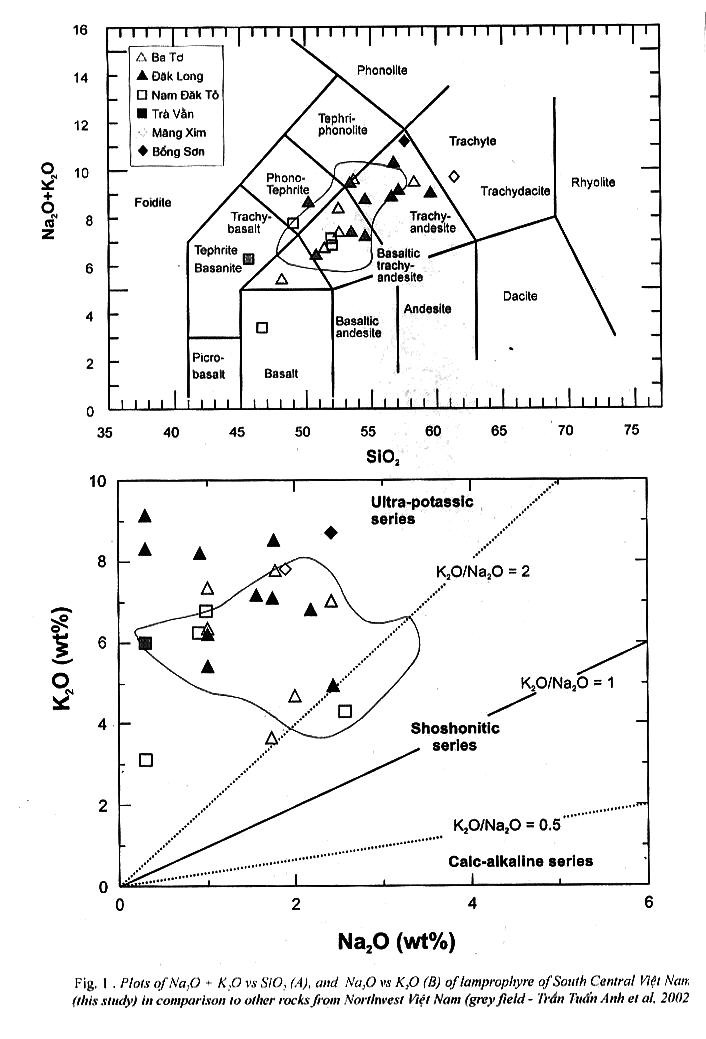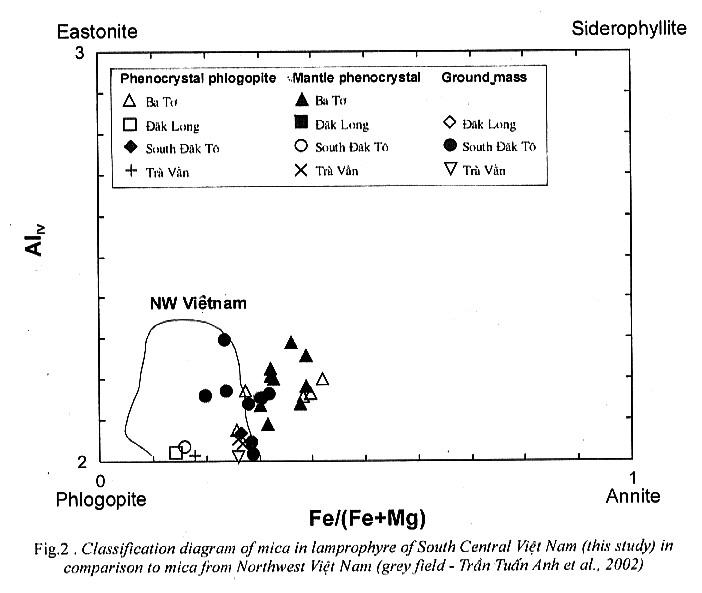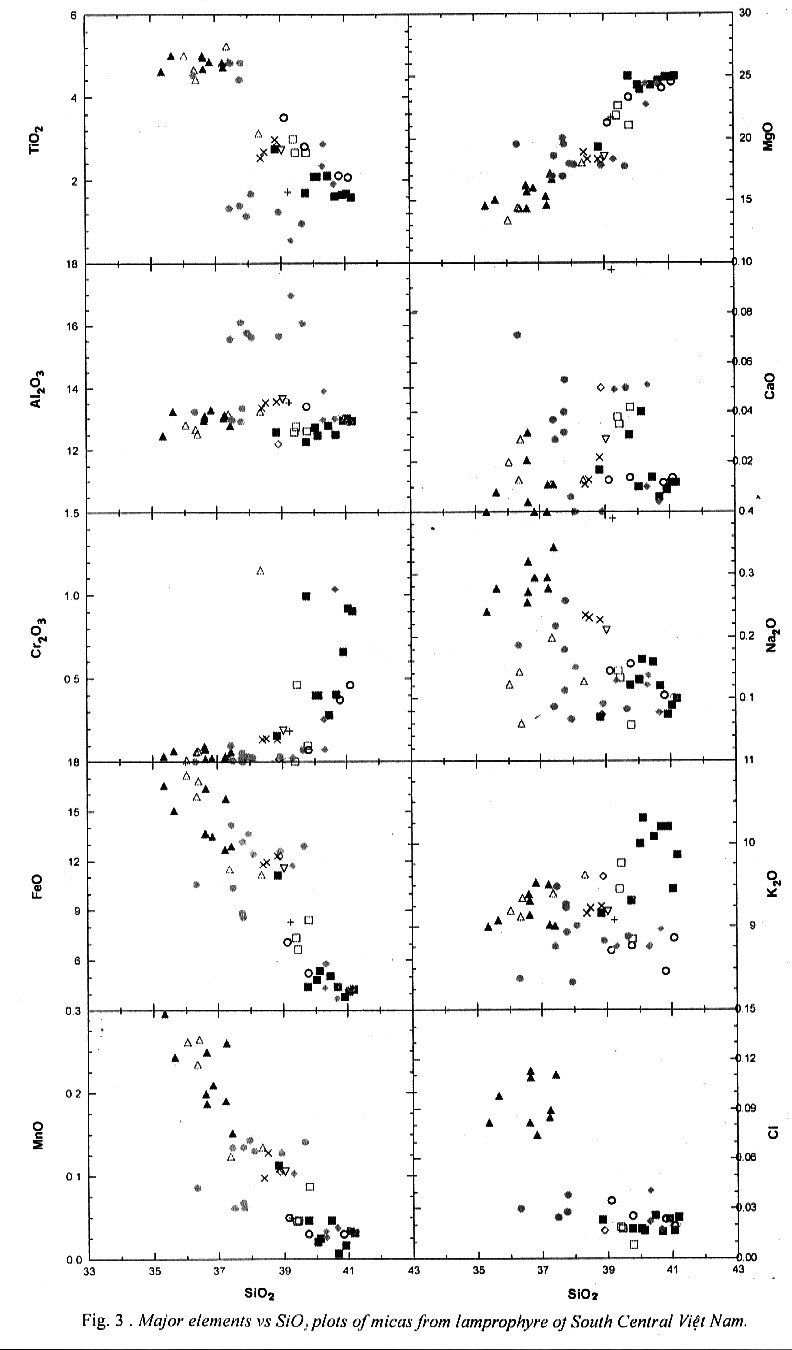THE
MINERALOGY OF PHLOGOPITE FROM LAMPROPHYRES OF
TRẦN
TUẤN ANH1, MAI KIM VINH2,
TRẦN TRỌNG HÒA1, NGÔ THỊ PHƯỢNG1, TRẦN VIỆT ANH1
1Institute of Geological
Sciences, NCNST, Hoàng Quốc Việt, Cầu Giấy, Hà Nội;
2Geological Mapping Division of the South, 200, Lý Chính Thắng Str.,
HCMC
Abstract: This paper
presents new data on phlogopites from different lamprophyre dykes in Đăk Long,
South Đăk Tô (Kon Tum); Măng Xim, Ba Bích, Ba Trang (Ba Tơ, Quảng Ngãi), and
other localities at
Two stage of crystallization
are identified: First stage characterized by low Ti, high Mg phenocrystal phlogopite.
In this stage, some turbulance changes in composition of the magma are identified
by mantled phenocrystal phlogopite, which have both normal and inverse zoning. The
second stage is represented by groundmass phenocrystal phlogopites, which are crystallized
in a shallow depth.
I. INTRODUCTION
Lamprophyres are potassic–ultrapotassic igneous rocks,
found in all over continents. Despite their small volume and petrologic perculiarities,
lamprophyre can potentially provide many informations on
the nature and evolution of their mantle source formation.
Research on the mineral composition by electronprobe
microanalyzer (EPMA) nowaday is one of the most advanced technique,
by which with minimum cost we can re-establish the formation history of magma, the
crystallization order of minerals in the rock, the origin and the forming condition
of magmas such as: pressure, temperature and volatile regimes.
Phlogopite is a water-bearing mineral phase,
which can exist in a wide range of pressure and temperature. The presence of
phlogopite in lamprophyres and peridotites represents metasomatism or
contribution of metasomatic agents into the formation of the mantle-derived
magma. This paper presents new data of phlogopite from different lamprophyre
dykes in Đăk Long, South Đăk Tô (Kon Tum); Măng Xim, Ba Bích, Ba Trang (Ba Tơ,
Quảng Ngãi), and other localities in
II.
GEOLOGICAL SETTINGS AND PETROGRAPHY OF LAMPROPHYRES
In Late Permian - Early Triassic, the major tectonic
phase occuring in
Lamprophyre magmatism is one of the post-orogenic
magmatism, which crops out at Đăk Long, South Đăk Tô (Đỗ Văn Chi et al., 1998;
Nguyễn Quang Lộc et al., 1998; Mai Kim Vinh et al., 2000, in Archives), Măng
Xim, (Nguyễn Thành Tín et al., 1997, in Archives, [1]), Ba Bích, Ba Trang, An
Quang [2]. These localities are situated at mobile belts, namely: Trà Bồng -
Khâm Đức, Pleiweck - Ngọc Hồi sutures, or located at the margin of ancient
continent (Kan Nack – Ngọc Linh) or major faults: Pô Kô River, Ba Tơ - Giá Vực.
They are formed as dykes of 0.5 - ~5 m in width, 50-100 in length, showing
porphyric texture with clinopyroxene and phlogopite as phenocrysts (Fig. 1). In some samples, amphibole
occurs in the phenocrystal phase. Their groundmas is composed mainly of glass and/or
small microlitic crystals of clinopyroxene, phlogopite, plagioclase and sanidine,
among them feldspars play an important role (Fig. 1).
Geochemically, these rocks range from basaltic to
trachytic and rhyolitic composition (Fig. 2). They show ultra-potassic or
shoshonitic character, which are high in potassium, aluminium, and silica and
low in magnesium contents. K-Ar dating age of the Đăk Long potassic lamprophyre
(DL-422/1) gives the age of 223.9 Ma (Late Triassic) [2]. On the stratigraphic
relation side, lamprophyre dykes do not penetrate geologic formations younger
than Late Triassic.
III. SAMPLES AND ANALYTICAL METHOD
Representative samples were collected from Ba Tơ, Đăk Long, South Đăk Tô, and Trà Vằn. These samples are
fresh, with LOI less than 3%. Their mineral composition was analyzed in polished
thin sections, by the electron-microprobe CAMECA Kevex at the
IV. MINERALOGY OF PHLOGOPITE IN LAMPROPHYRE
Phlogopite is a common mineral phase in all localities.
It occurs in the following paragenetic associations:
1.
Phenocryst (Phl1);
2.
Mantled phenocrystal phlogopite (Phlm)
3.
Groundmass (Phl2);
Phenocrystal phlogopite is strongly pleochroic, from
brownish to pale yellow and from pinkish hue yellow to reddish brown (Fig.1).
The intensity of pleochroism increases with the increase of titanium content. The
majority of phenocrysts are inclusion-free. They often have corroded and embayed
margins, indication of resorption in the magmas that formed their host rocks.
Mantled phologopites (Phlm) are found mainly in Ba
Tơ and Đăk Long lamprophyres. This feature proves that phlogopite appears to be
not a liquidus phase throughout the entire crystallization interval of the
magma, and the mineral may occur exclusively either
as phenocrysts or groundmass plates [7]. The mantles often exhibit stronger pleochroism
than the cores. Commonly, the core-mantle interface is not well defined and represents
a zone of strong continuous zoning rather than discrete overgrowth. This phlogopite
type probably results from magma mixing processes, in which crystals of relatively
earlier evolved phlogopite are incorporated into relatively later evolved magmatic
fluid.
The groundmass crystal phase (Phl2) consists
of poikilitic subhedral plates, with the size of about some hundreds micrometers
in maximum sise. They are scattered in the groundmass, in which the zoning is not
observed so far.

Chemical composition
The representative composition of phenocrystal, mantled phenocrystal and groundmass phlogopites
are presented in Table 1, 2, 3. The significant features of mica in all lamprophyres
are: 1/ high in Al2O3, varying from 12.20 to 16.97 wt.% (Table 1-3); 2/ relatively high in MgO
(11.08-25.00 wt.%); and 3/ wide variation of titanium (0.57 - 5.25 wt%). On the
classification diagram, all analyses are of phlogopitic nature, with the changing
trend toward siderophyllite. Compared to phlogopite from lamprophyre and lamproite
of
Phenocrystal phlogopite (Phl1) of Đăk
Long, South Đăk Tô and Trà Vằn has highest SiO2 and MgO
contents (SiO2 = 35.16-41.62 wt%; MgO = 13.42-24.39 wt.%, Table 1, Fig.4), it is lowest in FeO*, MnO, and (FeO*
= 3.67 – 8.50 wt.%; MnO
= 0.026 – 0.11 wt%; Table 1, Fig.4). Their
chromium content varies in a wide range (Cr2O3 = 0.001 –
1.04 wt %, Table 1, Fig 4). Phenocrystal phologopite from Ba Tơ
lamprophyre is characterized by highest content of titanium, iron and manganese
(TiO2
= 1.33 – 5.25 wt%, FeO* = 3.67 – 17.19, MnO = 0.12-0.26 wt.%),
lowest in magnesium (MgO = 13.42 – 23.84 wt%, Table.1, Fig.4). There are
no significant difference of Al2O3, CaO, Na2O and
Cl content between phenocrystal phlogopite and the other phlogopite types (Fig.
4).
Mantled phlogopite (Phlm) seems to be an intermediate
variety between phenocrystal and groundmass phlogopites. In comparison to phenocrystal
phlogopite, it has similar Ti, Al, Na and Cl contents, and is lower in Fe, Mn, Ca,
higher in Cr, Mg, and K (Table 2, Fig.3). Among this group, Ba Tơ mantled
phlogopite has highest titanium (TiO2 = 4.63-5.01 wt%),
iron (FeO* = 9.14-16.54wt%), sodium (Na2O = 0.16-0.34 wt%), manganese
(MnO = 0.09-0.30 wt%), and chlorine (Cl = 0.07-0.11 wt%) contents, but is lowest
in magnesium (MgO = 11.08-16.72 wt%) and chromium (Cr2O3
<0.09 wt%) (Table. 2, Fig.3). In all phlogopite of lamprophyre, the zoning
trend is not so well-defined as in those from lamproite
of


The groundmass phlogopite (Phl2) is
widespread in all lamprophyre localities, except in Ba Tơ lamprophyre. Compared
to phenocrystal phlogopite, it is characterized by the lower content of
magnesium, silica, chromium, and potassium (MgO = 16.95 - 20.06 wt%, SiO2 = 36.32-39.65 wt%, Cr2O3
= <0.19 wt%, K2O= 8.33-9.60 wt%), but higher
content of iron, manganese (FeO = 8.62-14.16 wt%, MnO = 0.06-0.14 wt%) (Table 3, Fig. 3). Their calcium and sodium contents
vary in a wide range (Fig.3). Especially, in groundmass phlogopite of
South Đăk Tô lamprophyre, two different variation phlogopite
types are recorded: titanium-high along with aluminium-low and titanium-low accompanied
with aluminium-high types.



V. DISCUSSIONS AND CONCLUSIONS
In general, compositional significant features of
phlogopite in lamprophyres of
·
Phlogopite of lamprophyres of
·
Groundmass and mantled phenocryst phlogopites are
typically depleted in Cr, Mg, Si and enriched in Fe, Mn,
and Ti, relatively enriched in Al in comparison with phenocrystal phlogopite, and
thus may be considered to be more evolved than the later.
·
Compositional evolution trends are typical with the
decrease of Mg, slight decrease of Al and increase of Fe and the constancy or increase
of Ti. This feature may be caused by the increase of Fe2+, reflecting
the evolution toward titanian phlogopite-biotite solid solutions [7].
·
The presence of chlorine, instead of fluorine content
in all phlogopite types shows that they are not a typical phlogopite of lamproite.
Solid solution in phlogopite of
The phlogopite from
Hartman (1969) has proposed the existence of Ti4+
in the tetrahedral network, but experimental data from Robert [9] and Forbes
and Flower [3] show that this possibility is remote. Consequently, it is considered
that Ti exclusively occupies the octahedral net replacing divalent or trivalent
cations. They proposed the following substitution schemes:
2Mgvi2+ Û Tivi4+ + Forbes and Flower
(1974) (1)
Mgvi2+ + 2Siiv4+
= Tivi4+ + 2Aliv3+ Robert
(1976) (2)
Figure 5 shows that all phlogopites from
Wagner and Velder [12] have proposed a substitution
as follow:
Mgvi2+ + Siiv4+ = Tivi4+
+ Mgiv2+ Wagner and
Velder (1986) (3)
The (3) substitution fits quite well with phlogopite
of the lamprophyres of
Phogopite crystallizing process in lamprophyres
of the Central Việt Nam
The composition of phlogopite of the lamprophyre implies
the crystallization from a MgO-TiO2 rich, H2O-Cl
bearing magma. Experiments of different authors have been showing that phlogopite
is stable over a very wide range of pressure and temperature, ranging from the upper
crust to the upper mantle. Experiment study of Orlando and other [8] on a
wadeite-phlogopite system at 2-3 Gpa has been showing that
phlogopite is absent at 1300-1400oC temperature. Sato et al. [11]
concluded that phlogopite is stable at the depth shallower than 180-200 km in
the subcontinental mantle and shallower than 200 km in the mantle wedge at subduction
zones. Esperanca and Holloway [2], using a minette as starting composition, have
been determining that between 10 and 20 kbar and 1070-1200oC the TiO2
content of phlogopite increases with the temperature and pressure decrease and oxygen
activity increase . The highest titanium phlogopite (7.8 wt %) is formed at
1100o C at 10 kbar with oxygen activity equivalent to this of the QFM
buffer. Synthesized phlogopite contains 3.3-7.8 wt% TiO2, 14.7–16.3 wt%
Al2O3, and 6.2-11.2 wt% FeOT [2].
In conclusion, the mica from lamprophyre of
REFERENCES
1.
Bùi Minh Tâm và nnk. 1998. Đặc điểm thạch địa
hóa các đá mạch cao Mg-K vùng Măng Xim (Petro-geochemical characteristics of
Mg-K high vein rocks from the Măng Xim area). Địa chất và Khoáng sản, 6:
85-98. Hà Nội.
2.
Esperanca S., Holloway J. R., 1987. On the origin
of some mica lamprophyres: experimental evidence from a mafic minette. Contrib.
Mineral. Petrol., 95 : 207-216.
3.
Forbes W. C, Flower M. J. F., 1974. Phase relation
of titanphlogopite K2Mg4TiAl2Si6O20(OH)4:
a refractory phase in the upper mantle? Earth Planet. Sci. Lett., 22 : 60-66.
4.
Mai Kim Vinh, Nguyễn Hữu Tý, Huỳnh Trung, 2000.
Đặc điểm thạch học-khoáng vật, đặc điểm thạch địa hóa của các thành tạo
lamprophyr cao kiềm, lamproit (?) trong vùng Đak Long, tỉnh Kon Tum
(Petro-mineralogical and petro-geochemical characteristics of alkali-high
lamprophyre and lamproite (?) in Đăk Long area, Kon Tum province). Địa chất
tài nguyên môi trờng Nam Việt Nam - Công trình kỷ niệm 25 năm ngày thành lập
Liên đoàn BĐĐC Miền Nam, tr. 126-142. TP Hồ Chí Minh.
5.
Mai Kim Vinh, Dơng Văn Cầu và nnk, 2002. Đặc
điểm địa chất, thạch học, thạch địa hóa của lamprophyr cao kiềm trong vùng Ba
Bích (Quảng Ngãi) và An Quang (Bình Định) (Geological, petrographical and
petro-geochemical characteristics of alkali-high lamprophyre in the Ba Bích,
Quảng Ngãi and An Quang, Bình Định areas).
Địa chất tài nguyên môi trờng Nam Việt Nam, Liên đoàn BĐĐC Miền Nam, tr.
63-73. TP Hồ Chí Minh.
6.
Mitchell R. H., Platt R. G. &
7.
Mitchell R. H. & Bergman S. C., 1991. Petrology
of lamproites.
8.
9.
Robert J. L., 1976. Titanium solubility in synthetic
phlogopite solid solutions. Chem. Geol., 17 :
213-227.
10.
Rock
N. M. S., 1991. Lamprophyres. Blackie,
11.
Sato
K., Katsura T., Ito E., 1997. Phase relations of natural phlogopite with and
without enstatite up to 8 Gpa: implication for mantle metasomatism.
Earth and Planetary Science Letters, 146 : 511-526.
12.
Wagner
C. & Velde D., 1986. The mineralogy of K-richterite-bearing lamproites.
American Mineralogist, 71: 17-37.